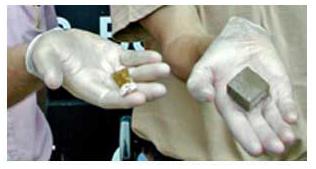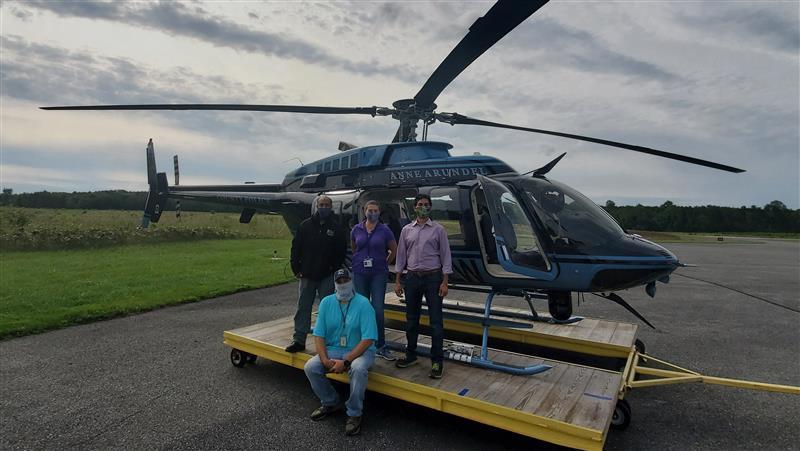The Public Health Concern
Rabies is a significant public health threat since rabid animals can come in contact with people and their pets. Rabies is a fatal viral infection. While pets can be vaccinated against rabies, people exposed to rabies must undergo a costly series of shots to protect them from the disease.
In 1997, the U.S. Department of Agriculture licensed a safe vaccine for use with raccoons. This vaccine has been used successfully in Maryland since 1998 and in more than 10 other states to control raccoon rabies.
Vaccine Distribution Plan
There are two bait versions that are distributed.

One (made of fishmeal and polymers) looks like a small brown brick. It is approximately 0.75 inches thick by 1.25 inches square and contains a small plastic bag of the liquid rabies vaccine, Raboral V-RG. The raccoon must bite into the bag to be vaccinated.
The second is similar to a condiment packet (such as ketchup), which has been coated with a waxy fishmeal attractant for raccoons. Inside the packet is the liquid rabies vaccine. The raccoon must bite into the packet to be vaccinated.
Baits are placed by ground teams in likely raccoon habitats in Anne Arundel County neighborhoods. The bait teams wear shirts with Department of Health logos and travel in marked County vehicles. In addition, the Anne Arundel County Police helicopter distributes baits in less populated areas and sometimes flies at low altitudes during the distribution.
The Vaccine
Raboral V-RG, a genetically engineered vaccine, contains a live vaccinia virus into which a small portion of the rabies virus has been inserted. It cannot cause rabies. It has been proven effective in immunizing raccoons and coyotes, and it has been shown to cause no harmful effects in more than 50 different species of birds and mammals, including dogs and cats.
From a human safety standpoint, Raboral V-RG presents a low risk. Millions of doses have been distributed in the U.S., Canada and Europe with only two reported cases of human infection due to vaccine contact. Both individuals made a full recovery. Although complications are rare, it is recommended that people younger than 18 years old, pregnant, or who have an immunodeficiency or a chronic skin condition avoid handling the bait. It is also recommended that care be taken in removing bait from a pet’s mouth.
Frequently Asked Questions
What if I find a bait near my home?
Leave it alone. If you don’t want the bait near your home, use gloves or put a plastic bag over your hands to pick it up and toss it into the woods. Then, wash your hands. Bare hand contact with the bait alone is not a concern; however, it does have a strong fish odor, so handwashing is recommended.
What if my child picks up the bait?
If the packet containing the vaccine is not ruptured, wash your child’s hands with plenty of soap and water to help get rid of the fishy odor.
What if my child tears the vaccine packet or eats the bait?
It is not possible to get rabies from the vaccine. The offensive odor usually discourages a child from eating the bait. However, in the unlikely event your child bites into the plastic packet containing the vaccine or otherwise has direct contact with the vaccine liquid, you should contact your child’s physician and notify the Department of Health at 410-222-7192 for any follow-up action.
What if my dog, cat or ferret eats the bait?
The bait and vaccine are not harmful to animals, including dogs, cats, ferrets, livestock and wildlife. The bait may cause diarrhea or vomiting in dogs, cats or ferrets due to the high fat content of the bait.
What if my pet brings the bait into the house?
During bait placement and for at least two additional weeks, it is recommended that pets be kept indoors or on leashes outside. This will allow enough time for raccoons to eat the bait. If your pet does find the bait, discard the bait in the trash. Wear rubber gloves or put a plastic bag over your hands when discarding. Wash your hands after handling the bait and report any contact with the vaccine liquid to the Department of Health at 410-222-7192.
Can this vaccine be used to vaccinate my dog or cat against rabies?
No, the vaccine is approved only for use in raccoons. You should have your dog, cat or ferret vaccinated by your veterinarian or at a public rabies vaccination clinic offered by Anne Arundel County Animal Control. The law requires pets to be vaccinated against rabies.
Can I have some baits to distribute on my own?
The vaccine used in the ORV Project cannot be purchased for an individual’s use, and it is federally restricted for use in rabies control programs sanctioned by an approved federal or state agency. Extensive management and agency coordination are involved to make sure the vaccine is kept under strict temperature control and is distributed with close assessment of raccoon population and habitat, baiting densities, competitive species, distribution methods and frequency, public awareness, and safety procedures for humans and pets.
Why is the project carried out in the late summer and early fall?
This is a time when the baby raccoons are old enough to gather their own food; thus there is the possibility of reaching the largest number of raccoons with the bait. Although raccoons do not hibernate, they are less active during cold weather.
After this year’s project has been completed, do I still have to worry about rabies in the area?
Yes. The Department of Health cannot ensure that all raccoons are vaccinated. Raccoons or other animals with rabies could enter the area after the baiting; however, the incidence of rabies should be greatly reduced.

